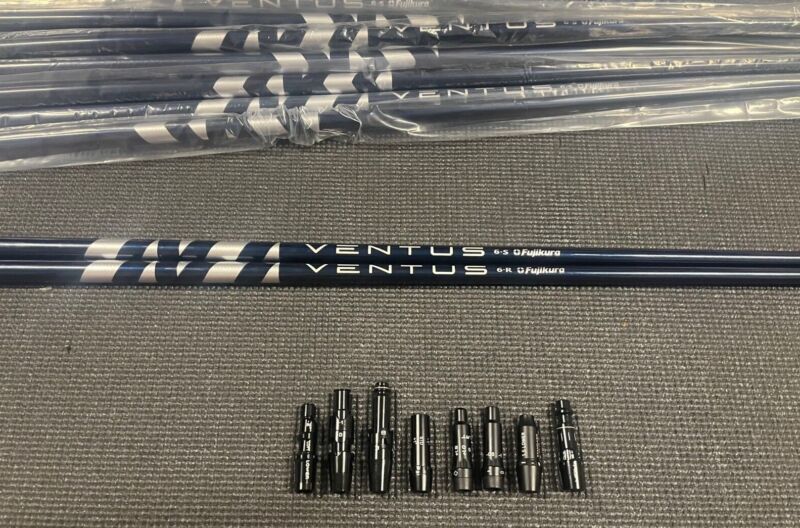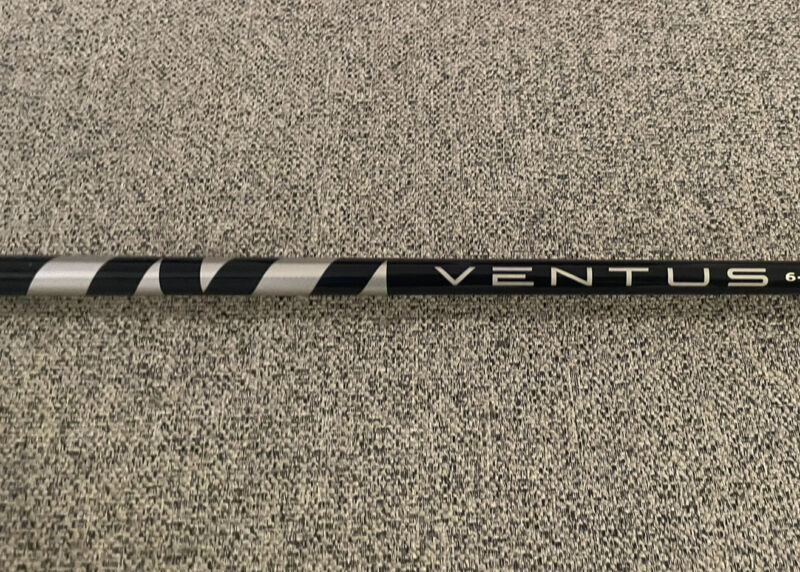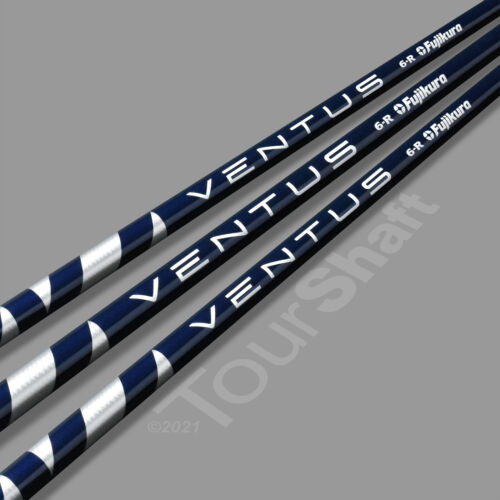Fujikura Ventus Blue 5 vs. 6: The Ultimate Comparison
The Fujikura Ventus Blue series is a testament to the golf shaft technology’s massive improvement.
The high-performance shaft is designed to provide maximum speed, consistency, and accuracy.
It comes in different models, including the popular 5 and 6 options. Each model caters to different swing speeds and players’ preferences.
This article is for you if you’re unsure of their key specifications and differences.
The first part of this article will be reviewing each model and then we can look at the differences between the Ventus Blue 5 and 6 so you can choose the most suitable for your game.
However, before then, let’s lay a solid foundation by reviewing the entire Fujikura Ventus shafts lineup.
Are you ready?
About Fujikura Ventus Shafts

Fujikura Ventus shafts belong to the most technologically advanced fairway wood and driver shafts category globally.
They are crafted to produce immense and exacting performance and cater to golfers of all swing speeds to help improve accuracy, range, and player consistency.
The lineup consists of three shaft series, each color coded.
It includes Fujikura Ventus Red, Black, and Blue, corresponding to varying launch profiles.
The Fujikura Blue series was the first of the lineup to feature the innovative VeloCore technology advancements.
It includes a multi-material design that offers incredible stability through impact and transition.
The Blue series boasts a slightly less aggressive mid-launch profile than the Ventus Black.
The Blue shafts are available in different flex options such as stiff, extra stiff, and tour extra stiff options.
However, the regular flex options are limited and suitable for players with slower swing speeds. Finally, the shafts offer 5, 6, 7, or 8 model options.
Now, let’s expound on the features of the 5 and 6 models.
Overview Of Fujikura Ventus 5 and 6
Ventus Blue 5 Review

The Fujikura Ventus 5 model is developed to offer exceptional performance to players with moderate swing speeds.
It helps this golfer category to achieve optimal launch and spin characteristics for increased accuracy and distance.
It has a mid-high launch and low-mid spin profile.
This profile produces a low spin and high ball flight to keep the ball up in the air for an extended period and produce a longer carry distance.
The flex options include regular, stiff, and extra stiff flex, catering to different speeds and preferences.
Ventus Blue 6 Review

Conversely, the Ventus Blue 6 suits players with moderate-fast swing speeds.
It boasts a low-mid spin and mid-launch profile to help produce a generating ball flight with low spin.
As such, it helps maximize distance without compromising accuracy and control. The flex options include stiff, extra stiff, and tour-extra stiff options.
Velocore vs Non-Velocore Versions
The Fujikura Ventus shafts with VeloCore technology are designed to enhance stability and accuracy.
VeloCore technology involves a unique construction method that uses a multi-material bias core running the length of the shaft to keep the clubface more square during the swing.
Here are some differences between VeloCore and non-VeloCore versions:
- Stability and Accuracy: VeloCore technology enhances the stability of the shaft through the swing and at impact, reducing clubhead twisting and promoting a straighter shot. This leads to improved accuracy and consistency.
- Energy Transfer: VeloCore is designed to maximize energy transfer from the golfer to the ball. This can lead to increased ball speed and potentially greater distance.
- Torsional Performance: The multi-material bias core construction of the VeloCore shafts affects the torsional performance of the shaft, further enhancing the stability and control that a golfer can experience.
Non-VeloCore versions of the shafts, while still high-performing, won’t offer these specific benefits associated with the VeloCore technology.
However, the choice between a VeloCore and a non-VeloCore shaft will depend on your preferences, swing speed, and the specific performance you are seeking from your golf clubs.
Fujikura Ventus Blue 5 vs 6: Comparison
Weight
The Ventus Blue 5 has a weight range of 55-65g, while the Blue 6 has a range of 65-76g.
The weight range indicates that the Blue 5 is lighter than the Blue 6, making it suitable for players with slower swing speeds or who prefer a lighter club.
The heavier Blue 6 model is ideal for players with faster swing speeds.
Flex Options
As established above, both shafts differ in their flex options. The Ventus Blue 5 has the Regular, Stiff, and X-Stiff options.
Conversely, the Blue 6 has the Stiff, X-Stiff, and Tour X-Stiff flex options.
The flex options signify that the Blue 6 has stiffer options, making it ideal for players who prefer such options.
Torque
The Ventus Blue 6 has a lower torque rating than the Blue 5.
As such, it provides better control and less twisting during the swing, especially for higher swing speeds.
Launch
The Ventus Blue 6 features a mid-launch profile, while the Blue 5 boasts a mid-high launch profile.
This means that the Ventus Blue 6 will produce a more penetrating ball flight that’s ideal for players who want a flatter trajectory.
On the other hand, the Ventus 5 will generate higher ball flight for players who have difficulty getting the ball up in the air.
Spin
Both Ventus Blue models have a low-mid spin profile. Generally, they are designed to offer a lower spin rate, but they do so differently.
When compared, the Blue 5 model produces a slightly higher spin rate than the Blue 6, thanks to its higher launch profile.
Price
Due to its heavier weight and stiffer flex options, the Ventus Blue 6 is generally more expensive than the Ventus Blue 5.
Ventus Blue Swing Speed Chart
Fujikura Ventus Blue 5
- Weight: 58-59 grams
- Length: 46
- Flex options: Regular, Stiff, and X-Stiff
- Torque: 3.3-4.0 degrees
- Launch: Mid-High
- Spin: Low-Mid
Fujikura Ventus Blue 6
- Weight: 65-69 grams
- Length: 46
- Flex options: Stiff, X-Stiff, and TX (Tour X-Stiff)
- Torque: 3.1-3.5 degrees
- Launch: Mid
- Spin: Low-Mid
For the full chart, you can visit the Fujikura website here.
Fujikura Ventus 5s vs. 6s: How Do They Compare?
Remember, these shafts come in different colors, with the Red, Blue, and Black being more popular. Each of these has come in slightly different specs.
The numbers you have there typically represent the weight in the shaft. So, a 5s would be 50g while Ventus 6 would be around 60g.
The letters usually represent the shaft flex, so (S, X, R) stands for Stiff, Extra Stiff, and Regular.
Therefore, a Ventus 5S would likely be a slightly lighter and potentially less stiff shaft than a Ventus 6S, leading to differences in feel and performance that could affect the ball’s flight and spin characteristics.
The “S” in both indicates that they are stiff shafts.
According to information on the manufacturer’s website, the weight and length of the Ventus Blue 5s are 59 and 46.
Similarly, the 6s have a weight and length of 65 and 46 respectively. So, the 6s comes with an extra 6g in weight, which may or may not affect your performance depending on your skills.
The 5r and 6r have very similar specs too. Note that we are only talking about Ventus Blue here as other colors have different specs.
Final Thoughts: Ventus Blue 5 or 6?
The choice between the Ventus Blue 5 and Ventus Blue 6 will depend on what each player wants and their playing style.
Golfers with slower swing speeds or who prefer a lighter club may find the Ventus Blue 5 a better fit, while golfers with higher swing speeds or who prefer a heavier club may choose the Ventus Blue 6.
Additionally, golfers who need help getting the ball in the air may find the higher launch profile of the Ventus Blue 5 to be beneficial.
At the same time, those who prefer a flatter trajectory may choose the Ventus Blue 6.
Working with a professional club fitter is recommended to determine the best fit for your game.
Related Posts:
- KBS Tour 130X vs. X100: Which is Better?
- Are Vokey Wedges Forged or Cast? Find Out!
- How To Mark a Golf Ball with a Sharpie

Want to Get Better at Golf?
Get "Ben Hogan's Five Lessons" and join thousands of others improving their golf skills.
Learn the Fundamentals: Stance and Posture > Golf Grip > The Swing.
This book has LOADS of positive reviews. THOUSANDS OF REVIEWS. A MILLION COPY SOLD. CHEAP!
Get the Book Here

Great information, thank you very much!!